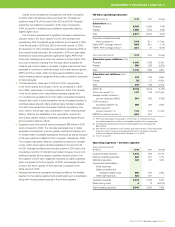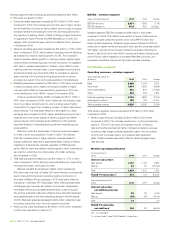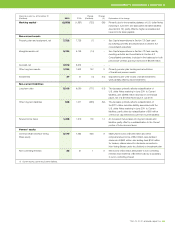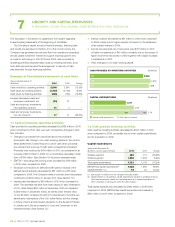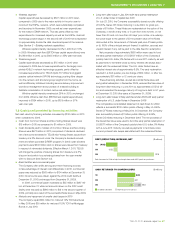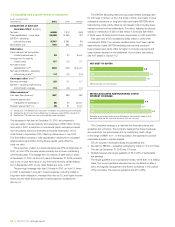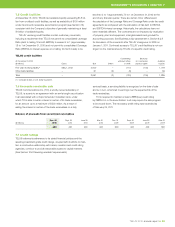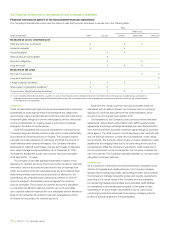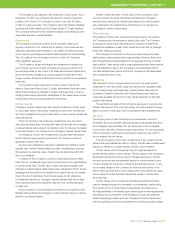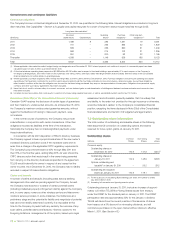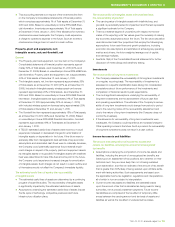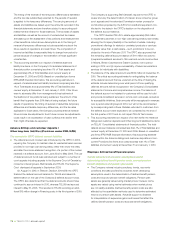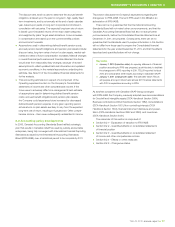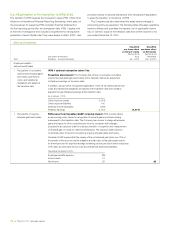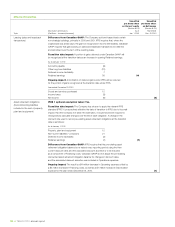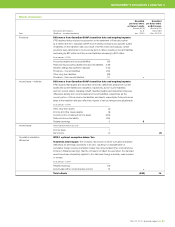Telus 2010 Annual Report Download - page 75
Download and view the complete annual report
Please find page 75 of the 2010 Telus annual report below. You can navigate through the pages in the report by either clicking on the pages listed below, or by using the keyword search tool below to find specific information within the annual report.
TELUS 2010 annual report . 71
MANAGEMENT’S DISCUSSION & ANALYSIS: 7
Similar to fixed-rate debt, the fair value of the Company’s cross
currency interest rate swap derivatives fluctuates with changes in
market interest rates as the interest rate swapped to is fixed; absent
early redemption, the related future cash flows do not change due
to changes in market interest rates.
Other price risk
If the balance of short-term investments includes equity instruments,
the Company would be exposed to equity price risks. The Company
is exposed to equity price risks arising from long-term investments
classified as available-for-sale. Such investments are held for strategic
rather than trading purposes.
The Company is exposed to other price risk arising from cash-
settled share-based compensation (appreciating Common Share and
Non-Voting Share prices increase both the expense and the potential
cash outflow). Cash-settled equity swap agreements have been entered
into that establish a cap on the Company’s cost associated with its
net-cash settled share options and fix the Company’s cost associated
with its restricted stock units.
Market risk
Net income and other comprehensive income for the years ended
December 31, 2010 and 2009, could have varied if the Canadian dollar
to U.S. dollar foreign exchange rates, market interest rates and the
Company’s Common Share and Non-Voting Share prices varied by
reasonably possible amounts from their actual statement of financial
position date values.
The sensitivity analysis of the Company’s exposure to currency risk,
interest rate risk and other price risk arising from share-based compen-
sation is shown in Note 5(g) of the Consolidated financial statements.
Fair value
The carrying value of cash and temporary investments, accounts
receivable, accounts payable, restructuring accounts payable and short-
term obligations approximates their fair values due to the immediate
or short-term maturity of these financial instruments. The carrying values
of the Company’s investments accounted for using the cost method
do not exceed their fair values.
The carrying value of short-term investments, if any, equals their fair
value as they are classified as held for trading. The fair value is determined
directly by reference to quoted market prices in active markets.
The fair values of the Company’s long-term debt are based on
quoted market prices in active markets. The fair values of the Company’s
derivative financial instruments used to manage exposure to interest
rate and currency risks are estimated based on quoted market prices
in active markets for the same or similar financial instruments or on the
current rates offered to the Company for financial instruments of the
same maturity as well as the use of discounted future cash flows using
current rates for similar financial instruments subject to similar risks
and maturities.
The fair values of the Company’s derivative financial instruments
used to manage exposure to increases in compensation costs arising
from certain forms of share-based compensation are based upon
fair value estimates of the related cash-settled equity forward agreements
provided by the counterparty to the transactions (such fair value esti-
mates being largely based upon the Company’s Common Share and
Non-Voting Share prices as at the statement of financial position dates).
The Company has significant debt maturities in future years. As at
December 31, 2010, the Company has access to a shelf prospectus,
in effect until October 2011, pursuant to which it can offer $2 billion
of debt or equity securities. The Company has credit facilities available,
including a $2 billion facility until 2012 (see Section 7.5 Credit facilities).
The Company believes that its investment grade credit ratings provide
reasonable access to capital markets.
Currency risk
The Company’s functional currency is the Canadian dollar, but it
regularly transacts in U.S. dollars due to certain routine revenues and
operating costs being denominated in U.S. dollars, as well as sourcing
some inventory purchases and capital asset acquisitions internationally.
The U.S. dollar is the only foreign currency to which the Company
has a significant exposure.
The Company’s foreign exchange risk management includes the
use of foreign currency forward contracts and currency options to fix
the exchange rates on short-term U.S. dollar denominated transactions
and commitments. Hedge accounting is applied to these short-term
foreign currency forward contracts and currency options on an exception
basis only.
The Company is also exposed to currency risks in that the fair
value or future cash flows of its U.S. dollar denominated long-term debt
will fluctuate because of changes in foreign exchange rates. Currency
hedging relationships have been established for the related semi-annual
interest payments and principal payment at maturity.
Interest rate risk
Changes in market interest rates will cause fluctuations in the fair value
or future cash flows of temporary investments, short-term investments,
short-term obligations, long-term debt and/or cross currency interest rate
swap derivatives.
When the Company has temporary investments, they have short
maturities and fixed rates, thus their fair value will fluctuate with changes
in market interest rates; absent monetization prior to maturity, the related
future cash flows do not change due to changes in market interest rates.
If the balance of short-term investments includes debt instruments
and/or dividend-paying equity instruments, the Company could be
exposed to interest rate risks.
As short-term obligations arising from bilateral bank facilities, which
typically have variable interest rates, are rarely outstanding for periods
that exceed one calendar week, interest rate risk associated with this
item is not material.
In respect of the Company’s currently outstanding long-term debt,
other than for commercial paper and amounts drawn on its credit facilities,
it is all fixed-rate debt. The fair value of fixed-rate debt fluctuates with
changes in market interest rates; absent early redemption and/or foreign
exchange rate fluctuations, the related future cash flows do not change.
Due to the short maturities of commercial paper, its fair values are
not materially affected by changes in market interest rates but its cash
flows representing interest payments may be if the commercial paper
is rolled over.
Amounts drawn on the Company’s short-term and long-term credit
facilities will be affected by changes in market interest rates in a manner
similar to commercial paper.


